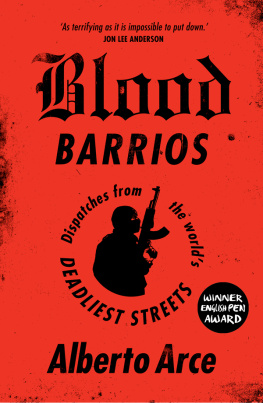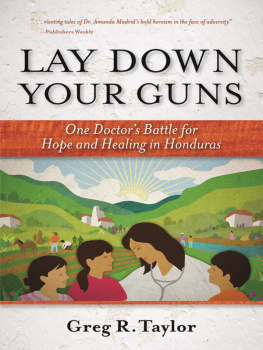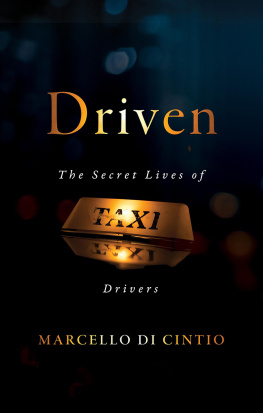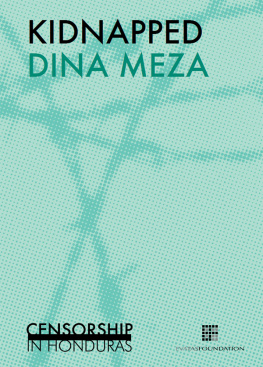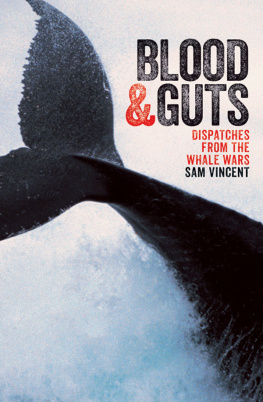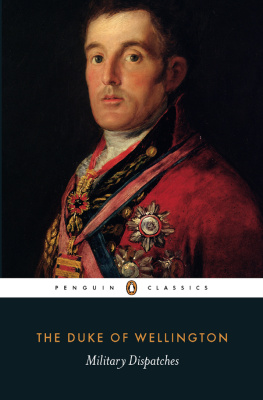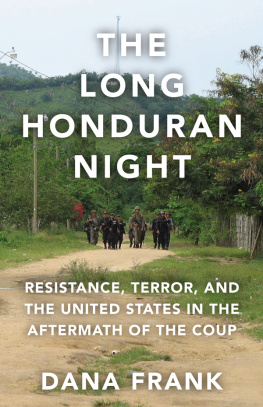
It takes a true reporter gutsy, bloody-minded, driven to work the streets of Tegucigalpa. Alberto Arces ballsy, bravely-told account marks him out as the real deal. The world needs more reporters like Arce who meet bullets with ink, head on. This is a troubling, gritty, brutally truthful book.
Oliver Balch, author of Viva South America!
Alberto Arce writes with stunning power and pace. Under the most difficult circumstances, he tells stories from violence-torn Honduras with an authenticity that reveals to readers terrible realities and the victims, but with an elegance that suggests there are no false notes [He is] a journalist who seems fearless.
American Society of News Editors
Reminiscent of The Wire . Blood Barrios is full of perceptive vignettes, each of which shows how cocaine trafficking, and the war on the traffickers, have sent the country spiraling into the abyss. Arces tone is that of a journalist teetering on the brink of despair.
Tom Feiling, author of Short Walks from Bogot
It took courage for Arce to write what he did in such a lawless place naming names.
Tim Ferguson, Forbes and jury member for the Overseas Press Club Award
Arces stories uncovered government-sanctioned death squads, human rights abuses in prisons and corruption among police and military forces. Overcoming a lack of public records available to him, Arce persuaded sources to give him copies of government documents and developed sources within the government, military, court systems and NGOs. He befriended prison officials and gang members alike to gain access to areas they controlled. Arce was eventually pulled out of Honduras after he was warned his reporting would get him killed.
Investigative Reporters and Editors (IRE)
BLOOD
BARRIOS
Dispatches from the
Worlds Deadliest Streets
ALBERTO ARCE
TRANSLATED BY JOHN WASHINGTON
AND DANIELA UGAZ
Illustrated by Germn Andino

Blood Barrios: Dispatches from the Worlds Deadliest Streets was first published in 2015 by Zed Books Ltd, The Foundry, 17 Oval Way, London SE11 5RR, UK
This ebook edition was first published in 2018
www.zedbooks.net
Copyright for the text Alberto Arce, 2015.
Copyright for the illustrations Germn Andino, 2015.
The rights of Alberto Arce to be identified as the author of this work have been asserted by him in accordance with the Copyright, Designs and Patents Act, 1988
Typeset in Haarlemmer by seagulls.net
Cover design: David A. Gee
All rights reserved. No part of this publication may be reproduced, stored in a retrieval system or transmitted in any form or by any means, electronic, mechanical, photocopying or otherwise, without the prior permission of Zed Books Ltd.
A catalogue record for this book is available from the British Library
ISBN 978-1-78699-049-5 pb
ISBN 978-1-78699-051-8 pdf
ISBN 978-1-78699-052-5 epub
ISBN 978-1-78699-053-2 mobi
CONTENTS
What helped me endure so long in Honduras was my constant desire to return home to see Sarah and Selma.
I want to thank the three editors of Associated Press, Marjorie Miller, Trish Wilson, and Katherine Corcoran, who gave me the opportunity, the means, the time, and the resources to cover for almost three years the events of a country that, in theory, matters to no one.
So, when we all, all of us, have killed one another, and between Guatemala and Nicaragua nothing is left but one hideous and solitary puddle of blood, these texts may help the countries of the future not turn out like us...
(Juan Martnez)
In the last fifty years, Central Americans have survived twelve coups dtat, one successful revolution and two failed revolutions, four declared wars, one genocide, one American invasion, eighteen hurricanes, and eight earthquakes. To the 320,000 dead from the wars of the 1980s we add 180,000 homicides. Most of these occurred in Honduras, where more than 55,000 people have been murdered in the last decade.

Youll notice the delicate pink flowers of the bougainvillea crawling over the cobblestoned street corners, the dusty mudbrick of the adobe, and the red tiles of the colorful houses, but only if you can get your head out of the volcano.
Living in Teguz is like drowning inside a volcano. In Tegucicrateras some of us call it when there are no Hondurans around to hear usyou leave your house at six in the evening, you have your daughters tricycle wedged under your arm, and, on the street corner in Parque de la Leona, you approach the small group of people gathered around a dead body. You smell the blood; you coolly look at the bullet hole stamped into the headyouve learned to contain your nauseaand you begin, without your notebook, to ask questions, just out of curiosity, just as a citizen. No one can live in a place for two years without feeling a part of it.
To get your head out of the volcano you have to pierce through the hills of trash and the dogs that live in them, the invasive labyrinth of electrical cables and bootlegged wiring, the car exhaust, the pervasive sound of the cityscape, and the night that falls like a blanket over streets without lampposts or traffic lights. As you lift your head youll start to notice changes in the weather, the rain. By this point youve learned to hurry to beat the mudslide that will soon flood the neighborhood, to stick a hand out of the window to wave on the taxi behind you, and to drive on through the night with the anxiety of a junkie in search of one of the few gasoline stations that sell Marlboro Reds.
To exist here you have to learn to live with fear, rage, boredom, impotence, and frustration. The boredom of interviewing politicians and bureaucrats, the frustration that in a country where a woman is murdered every twenty hours, the half-dozen protesters gathered at a feminist rally cant agree on what their banner should read. The anger of seeing a boy drop out of school to push a squeaking ice cream cart eight hours a day. The impotence of thinking about that girl who was shot in the leg by her dad, but who doesnt want to go to the hospital because they might report the accidentthe accident that happened when he, a police officer, was cleaning his gun while waiting for dinner to be ready after a 72-hour shift.
To survive the volcano, Ive learned to protect myself against the ugly. I dont need Google glasses; I only need my time machine. In the dead hours of a traffic jam, Ive learned to imagine the city in black and white. Dozens of times, Ive dreamed of the Teguz of the 1940s, 1950s, and 1960s, with its colonial houses, its gossiping crowds huddled at a church entrance, its billiards, its political hangouts, like the barbershop where Kapuscinski would get a straight shave before waiting in line to send a telegram, and where old men still sit to while away the hours, the type of men who touch the brims of their sombreros to greet passersby.
Most foreign journalists dont pass the first cut, not even with the generous hazard-tax they can charge; they throw in the towel, leaving behind a defeated city where even party streamers are made of rusty barbed wire. Nicaragua, just a few hours away by car, is too close to Honduras to seem a legitimate place of refuge, and correspondents (myself included) lack the intimacythe political or religious willto live in Honduras without being Honduran. But those of us who make the cutthose of us who think weve made the cutwe fight it out together in our Central American Melrose Place. In the Giraldilla , protected and surrounded by eucalyptus and guava trees, by squirrels, and by the aloe vera that covers the wall separating us from the streets, and protected by Lucas, a father of eleven children who doesnt know how to read or write, but who, with a machete in hand, guards over us night after night.
Next page
